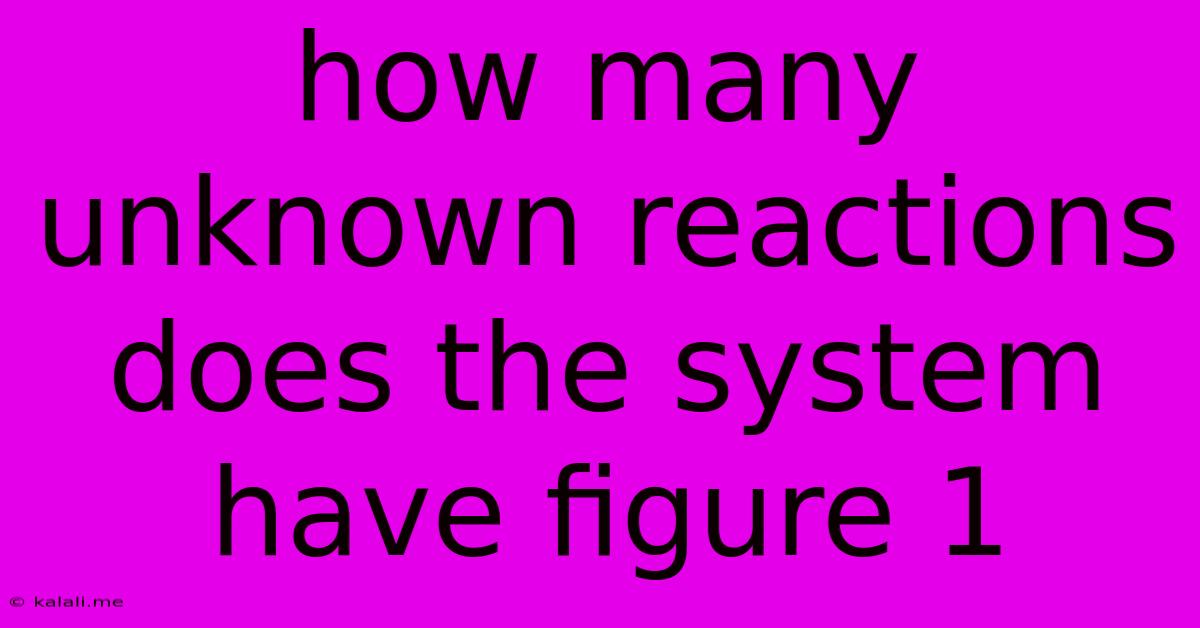How Many Unknown Reactions Does The System Have Figure 1
Kalali
Jun 15, 2025 · 3 min read

Table of Contents
How Many Unknown Reactions Does the System Have? Deciphering Figure 1
This article addresses the question: "How many unknown reactions does the system have in Figure 1?" Understanding this requires careful analysis of the provided figure (which, unfortunately, I cannot see as I am a text-based AI). However, I can provide a framework for determining the number of unknown reactions based on common representations in chemical engineering, reaction kinetics, and process systems engineering. This framework will allow you to apply the method to your Figure 1.
What Constitutes an "Unknown Reaction"?
Before we begin, it's crucial to define what constitutes an "unknown reaction" in the context of your Figure 1. This could mean several things depending on the nature of the figure:
- Reactions with unidentified products: You might know the reactants, but the products formed are unknown.
- Reactions with unknown rate constants: The reactants and products are known, but the reaction rate (how fast it proceeds) is not characterized.
- Reactions whose existence is entirely unknown: The figure might show a system where a reaction is suspected but not yet identified.
- Stoichiometry Uncertainties: The precise molar ratios of reactants and products might be unclear.
Analyzing Figure 1: A Step-by-Step Approach
To determine the number of unknown reactions, follow these steps, adapting them to the specifics of your Figure 1:
-
Identify all reactions: Carefully examine Figure 1. Is it a reaction network diagram, a process flow diagram (PFD), a chemical structure, or something else? Each representation will require a slightly different approach. List all the chemical reactions depicted, even if some information is incomplete.
-
Classify each reaction as known or unknown: For each reaction identified, decide if it's fully characterized (known) or if any aspect is unknown (as defined in the previous section). Consider:
- Reactants and Products: Are all the reactants and products identified?
- Reaction Rate: Is the rate constant or a rate equation known?
- Reaction Mechanism: Is the detailed mechanism of the reaction understood?
- Stoichiometry: Are the stoichiometric coefficients (molar ratios) accurately determined?
-
Count the unknown reactions: Once you've classified each reaction, simply count the number of reactions that fall into the "unknown" category.
-
Consider potential ambiguities: It is possible that some reactions might be partially known. For example, you might know the reactants and products but lack information on the reaction kinetics. Carefully consider each case and use your best judgment to classify them.
Example Scenario (Illustrative):
Let's say Figure 1 shows a reaction network with four reactions:
- A + B → C + D (Known)
- E + F → G + ? (Unknown product)
- H + I → J + K (Known, but rate constant unknown)
- L → M + N (Completely unknown reaction)
In this example, there are three unknown reactions: one with an unknown product, one with an unknown rate constant, and one completely unknown reaction.
Conclusion:
Determining the number of unknown reactions in Figure 1 requires a systematic approach. By carefully analyzing the figure and following the steps outlined above, you can precisely quantify the level of uncertainty in the system's reaction network. Remember to clearly define what constitutes an "unknown reaction" based on the specific details provided in your Figure 1. This approach will allow for a rigorous and accurate analysis.
Latest Posts
Latest Posts
-
80 Of X Is Equal To 100
Jun 15, 2025
-
What Are The First Five Multiples Of 5
Jun 15, 2025
-
What Is The Coefficient Of Discharge
Jun 15, 2025
-
Consider Steady State Conditions For One Dimensional Conduction
Jun 15, 2025
-
Difference Between High Pass And Low Pass Filter
Jun 15, 2025
Related Post
Thank you for visiting our website which covers about How Many Unknown Reactions Does The System Have Figure 1 . We hope the information provided has been useful to you. Feel free to contact us if you have any questions or need further assistance. See you next time and don't miss to bookmark.